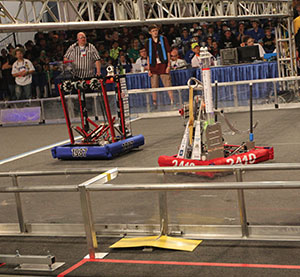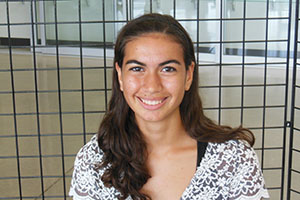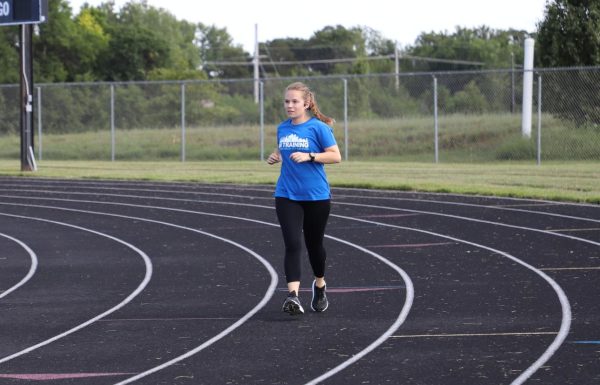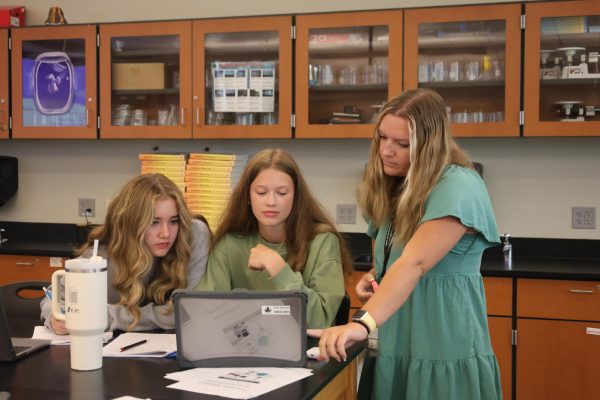Students design, build and program robots for competitions

Welcome to the only sport where the players on the field have no control over their actions and display no signs of fear, excitement or interest.
The MCC Business & Technology Campus is filled with hundreds of screaming fans rapidly waving signs for their favorite team. Others navigate through tides of people to grab food from the concessions stand before they miss any of the action. But the players are completely oblivious to all of the people depending on them, all of those who came to watch them. In fact, they aren’t even human. Welcome to the FIRST Robotics Competition (FRC).
Game Overview
All over the world, students compete in the the FIRST (For Inspiration and Recognition in Science and Technology) robotics program, where teams have six weeks to design, build and program robots that will compete in a challenge against robots from other teams.
The FRC is trademarked as a “Sport for the Mind;” its founder, Dean Kamen, formed FIRST after “realizing that the way to get kids interested in science and technology would be to give them a sport to succeed in.”
“America, and by extension its youth, celebrates popular culture — professional athletes, musicians, and Hollywood celebrities,” Kamen said in the Huffington Post. “As a result, young people aspire to emulate their idols. If kids looked at Nicola Tesla or Bill Gates the way they look at LeBron James and Tom Brady, then I guarantee that our students’ enthusiasm for math and science would match their passion for Little League and Pop Warner.”
At the beginning of January, each robotics team across the globe watches a NASA-broadcasted video that explains what the robots will have to be able to do at the competition that year. This year, the challenge was called Aerial Assist. The objective was for the main robot to launch a ball into either low or high goals within a two and a half minute time frame.
Seven students from Southwest help comprise the total team of about 65 people at CAPS known as the Metal Mustangs. At the Greater KC Regional on March 13-15, the team made it to the final elimination round and won the Judges’ Award, which, according to FIRST, is based on a “team’s unique efforts, performance, or dynamics merit recognition” during the competition.
Player Profile: Freshman Mickey Van Horn
Freshman Mickey Van Horn used to build pretty much everything, from little model cars and spaceships to solar-powered devices sold in kits at a mom and pop coffee shop. He always had containers and containers of Legos, so when he saw that his friend’s older brother was using them to build a working machine, he decided to join First Lego League (FLL) himself.
In FLL, students use Legos to build robots that compete in small competitions. Van Horn’s team consisted of five people, including freshman Abby Fry. The team built Van Horn’s favorite robot, known as Tank Bot, when he was in fourth grade.
“That was my pride and joy,” Van Horn said. “I was with that robot from start to finish. We’d always used traditional wheels, [but] that year I finally got my wish and got to use treads.”
At FLL competitions, Van Horn remembers him and his teammates leaving with their shirts completely covered with stickers and buttons that other teams would make; at FLL meetings, he recalls working in a teammate’s basement as the mom brought down homemade snacks. But even though FRC involves over 60 people and provides him with access to loads of heavy machinery, he said the transition from the middle school to the high school program didn’t feel much different.
“It’s different, but yet it’s still the same, because I’m still working on a team,” Van Horn said. “I’m still with people I don’t mind hanging out with; I still am doing the same thing I did with those people in the basement, but on a bigger scale.”
Van Horn said the biggest challenges include when there is a problem with an unknown source, so the team has to change everything else to adhere to the problem. However, at the same time, robotics has taught him how to move past challenges.
“[I’ve learned to] accept other people’s ideas if you want to succeed,” Van Horn said. “Robotics is not just about learning about machinery and stuff like that. You learn a lot about how to be a good teammate. I’ve learned a lot of life lessons that you couldn’t really learn anywhere else.”
Van Horn explained that robotics is “the thing for you if you aren’t an athlete” — he said one of the team members is handicapped, but in the sport of robotics, he is at no disadvantage.
“[It’s] not just a bunch of nerds sitting in front of computers and building things; it’s not just focused on one type of person,” Van Horn said. “You’ve got your weirdish people, really outgoing people, people who play lots of sports, book nuts — little bit of everybody in there. Nothing’s weird in robotics; no one’s weird in robotics — we’re all weird in a way, but that’s what keeps us all together.”
Van Horn plans on majoring in mechanical engineering at the University of Kansas and then owning a company that he can apply his degree to. Following the FIRST team spirit, he said his goal for the last competition was to “beat all the other teams with gracious professionalism.”
Player Profile: Zach Tolar
Junior Zach Tolar is just now considering a career in mechanical or nuclear engineering, but he’s always had an interest in the field. After graduating from FLL with juniors Jacob Hegna and Mat Orzechowski, he knew FRC was the next step. Now, “you can’t make him decide” what his favorite power tool is — “it’s like asking what’s your favorite kid” — and he loves the team mottos, which are “the beatings will continue until morale improves” and “measure with micrometer, mark with sharpie and cut with axe.”
“We don’t actually beat anyone, obviously — our coach, Mr. Ritter, is known for his very straight-forward coaching and discipline tactics,” he said. “The cut with axe one is pretty true. We spend a lot of time designing, a bit less time setting up our materials, and even less manufacturing. We do end up with a lot of mistakes and parts that were incorrectly made. But none the less we still get the job done.”
He said he’s learned a lot about CAD software, machines, design process and teamwork, but the team still argues a lot because there are so many different ideas; in the forming stages, if someone thinks he or she has good ideas but everyone votes for a different one, it can be hard to let that idea go.
“I feel like we’re not necessarily one big family, because there are lots of new people that not everyone necessarily knows,” Tolar said. “During lunch we sit in our friend groups, but when we’re together there’s definitely a team pride, especially at competitions.”
Tolar said the competitions are very exciting, with the spectators in the stands cheering on their teams and alliances. There’s lots of noise, and by the end of the day no one can talk.
“It’s very friendly,” Tolar said. “ You can just go up to people you don’t even know and just say ‘hi, I want to start a conga line.’ I’m not even kidding: [one year] they were playing ‘Cotton-Eyed Joe,’ and you know, being in Kansas, we all did the classic Kansas farmer thing [dance], and it turns out everyone else in the stands from other teams, from around the region, that we don’t even know, came down and they start doing it with us. We get a whole line of people doing that dance. It was really fun; it’s just a big robotics family.”
Player Profile: Wes Caldwell
When junior Wes Caldwell was in sixth or seventh grade, he and his dad Alec Caldwell, a project manager for software developers, replaced the existing software on Wes’s lego NXT robot with JAVA. This led Wes to take a Stanford class on JAVA online.
“By the time I got done with it, I wasn’t really interested in coding the little NXT robot anymore,” Wesl said. “I was like, ‘wow, look at all these cool programs I can make.’”
After JAVA, he got involved in learning C from another online Stanford course; he said “once you know one, the others are generally pretty easy to pick up as long as they follow the same paradigm.” The first real project that he finished was a Text Adventure Game where the goal was to help the player escape.
“I’ve been exposed to a lot more uses of programming, because I used to just code little game program stuff, like stuff to do my math homework for me, but through robotics I’ve been exposed to embedded systems, more web-based applications,” Wes said. “It’s been a pretty good experience.”
Wes didn’t join Lego League in middle school because “he was uninspired,” but he decided to join FRC after “seeing some flyers around school and going to the meetings that they told me to go to.” He found all the people to be “pretty cool,” so he thought, “hey, I can dig this.”
Wes’s freshman year, mentor Dan Ritter won the Woodie Flowers award. FIRST’s criteria says the award “recognize[s] mentors who lead, inspire, and empower using excellent communication skills.” Since it was the first robotics regional hosted in Arkansas, Woodie Flowers himself was there to present the award to the Metal Mustangs mentor.
“They read an excerpt from the essay, because every team submits an essay about their mentor and why they think he deserves the award, and I thought, ‘this sounds like a cool guy; I feel like I’d like a guy like that.’ Then they said it was Mr. Ritter…there was definitely some crying by all parties involved.”
One of Wes’s favorite robots was built the same year: it had vision tracking systems that allowed it to aim at a hoop and shoot. That was the year the team made it to Worlds, the championship event for all of the regional winners.
“It [Worlds] was massive,” Wess said. “It was in the Saint Louis Rams football stadium, so they had three fields set up on the area where they normally have the football field, and they had three competitions going on concurrently. The stands are filled; there are people everywhere. You go down under and there are pits everywhere where people are fixing [robots], putting new stuff on. It’s like a small city.”
During the season itself, Wes said there’s usually a back and forth between the build team and the programming team.
“There’s a paradigm of the mechanics team —the build team — doing something wrong, like breaking a wheel and then not fixing it, and then saying ‘hey, look, it curves to the left,’ and then blaming it on programming team, saying the right motor is turning faster,” he said. “So then we have to correct for that and turn the left motor faster, and that happens day by day, stuff like that. But this is my perspective. It’s all in good fun.”
Despite the difficulties, Wes thinks robotics has something for everybody and the team could always use more hands (“that’s a call to action”).
“There’s definitely guys who fit the programmer stereotype; guys who fit the build team stereotype, but we need other people too,” Wesl said. “We had a guy who graduated last year — his name was Ryan Harkins —I don’t think he ever once touched the robot or even looked at it. He didn’t even show up except for like competition days. [But] he was the spirit monster. He would like wear the team mascot — he had some animal costume [a horse] that he wore. It was fantastic. Ryan was a pretty cool guy. [He] got everybody hyped up during competitions, and not just for our team: just for all teams, just like everybody there.”
Coach Profile: Dan Ritter
Metal Mustangs mentor Dan Ritter started teaching in 1973 at JC Harmon High School in Kansas. After teaching in several high schools across the country, he started own company in Naples, Florida, building tennis courts — a company that expanded to the rest of Southwest Florida, the Caribbean and Central America. In 1999 he started teaching drafting at Bishop Miege, where he was the head football coach for seven years, before coming to Blue Valley North and finally to CAPS, where he now teaches digital electronics and sponsors the robotics team.
“My goal for the team is always, number one, they work together as a team — they take care of each other,” he said. “And gracious professionalism is the underlying thing. Everything we do in FIRST is about competing as hard as you can, but if the person you’re competing against needs a part, you give them that part.”
Over the years, Ritter has witnessed team members spending more time together: “they go play ping pong together; they have parties at each other’s houses.” He said “it’s actually like a subculture” in the same way a sports team is.
“It’s fun to see them grow in that way — communication skills and having a good group of friends,” Ritter said. “They do things together: they go play ping pong together, they have parties at each other’s houses, so it’s actually like a subculture, like if somebody was in the play or on a sports team. The ones that stick with it for four years end up being quite close. We’ve even hashed a few romances along the way.”
He also bonded with the team as well — a few of the students nominated him for the Woodie Flowers award without him knowing it.
“Last year I won the Woodie Flowers award in Arkansas. It was kind of funny because they were reading the description and I thought, ‘man, that really sounds like a cool man,’ and then they called my name and I thought, ‘man, I have the biggest liars on my team.’ But it was quite an honor, and it made me feel real good that the kids actually thought enough to do that, so that was a big deal to me.”
Ritter has taken his team to Worlds four out of the last eight years, twice to Atlanta and twice to St. Louis.
“The competitions are really fun,” he said. “They play music, there’s a jumbotron and they get to dance. I tell the kids that when we go to these things, we’re going to be involved. If they’re playing the chicken dance, I’m out there chicken-dancing with them. You can’t make a fool of yourself — you’ve got to do something really outlandish for anyone to even look at you. Purple mohawks, stuff like that — that doesn’t get much of a glance. Guys wearing girls’ skirts — you’ve got to do something pretty crazy. It’s a lot of fun — it’s the most fun that you’ll ever have, they say.”
Many of the team members refer to him as Coach Ritter. The team once created a t-shirt with the 10 biggest “Ritter-isms,” including his most famous mantra, “the beatings will continue until morale improves.” He said he tends to yell a lot to keep order, but the team members all get his humor.
“Generally speaking, I’ll let them fail,” he said. “Those are the best lessons; those are the hardest learned ones. Last year’s team worked six weeks on a terribly difficult problem and then we didn’t get to test it until the last day and it didn’t work, so then we had to actually find some way to do something with that robot and we ended up actually converting it to a defensive robot and then just competing. But that’s what happens in life — you’ve got your heart set on one goal and then you don’t always get there. And then what do you do, cry about it? Maybe for a little while, but then you’ve got to go forward, right? So that’s life.”
But despite their misfortunes, the team has had their hard work pay off at other times.
“I can remember Oklahoma City a few years ago — we actually won that competition — and it was in the finals and every robot in our alliance was broken, including ours. The other two teams, their pit was full of adults basically doing the work for them, and our kids were down there and they were doing it and I was sitting in the stands. That’s my favorite memory because that’s what I’m looking to do.”
Ritter says the students in robotics are “just like any other group of kids.”
“There’s nothing I could tell you saying that this is what a robotics kid looks like — I don’t know what they look like,” he said. “They’re all different. This is a group of kids that works on snow days and weekends and evenings. I don’t think you could pay them to work as hard as they can, and they would not do it if they were not having fun.”

2014 marks Ananda Bhatia's third year in newspaper and first year as editor-in-chief. She is incredibly excited to work with such a talented and hard-working...






